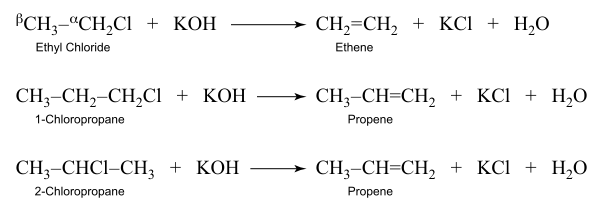Dehydrohalogenation

Dehydrohalogenation is an organic reaction in which alkyl halide when boiled with alcoholic alkali gives corresponding alkene.[1] It is also called a β-Elimination reaction and is a type of elimination reaction.
In this reaction, the halogen on the carbon in the alkyl halide reacts with hydrogen present on the β-carbon releasing hydrogen halide. Hence an alkene is formed due to formation of a double bond between the α- and β-carbon. Zaitsev's rule helps to explain regioselectivity for this reaction type. The opposite transformation is called hydrohalogenation.
Reactions

Here ethyl chloride reacts with potassium hydroxide dissolved in ethanol, giving ethene. Likewise, 1-chloropropane and 2-chloropropane give propene.
Chlorobenzene does not react with potassium hydroxide due to the presence of the benzene ring, which, due to stabilization as a result of aromaticity, does not give conventional elimination, as it would lead to a very unstable benzyne intermediate.
Promoting elimination
In general, the above reaction of haloalkane with potassium hydroxide would compete with an Sn2 nucleophilic substitution reaction (minor product) because OH− is a strong, sterically unhindered nucleophile. Perhaps a better reagent would be a deprotonated alcohol such as potassium tert-butoxide ([CH3]3CO− K+) or, because it is an oxide anion and thus a strong base and nucleophile, potassium ethoxide (CH3CH2O− K+), and because of steric hindrance, thereby promoting an elimination mechanism instead of a substitution mechanism.
External links
References
- ↑ March, Jerry (1985), Advanced Organic Chemistry: Reactions, Mechanisms, and Structure (3rd ed.), New York: Wiley, ISBN 0-471-85472-7
|